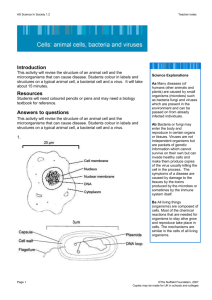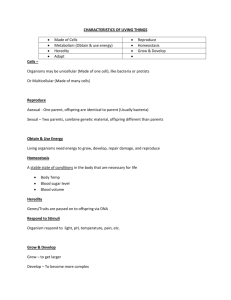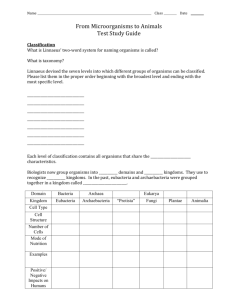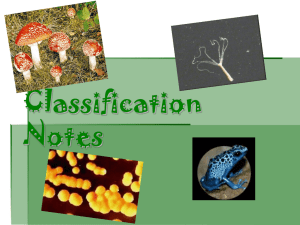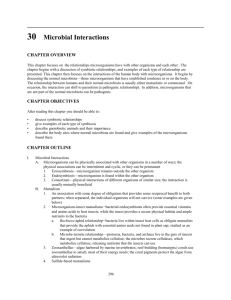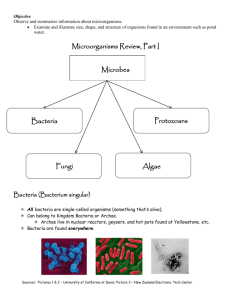Worksheet - Mr Science
advertisement
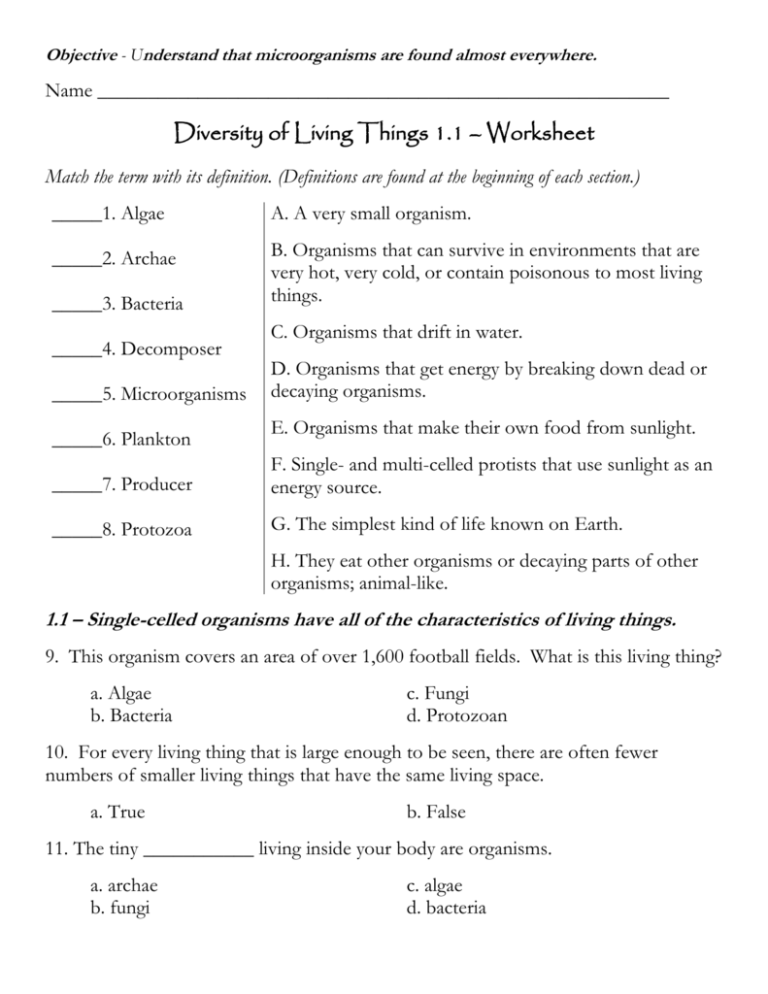
Objective - Understand that microorganisms are found almost everywhere. Name _________________________________________________________ Diversity of Living Things 1.1 – Worksheet Match the term with its definition. (Definitions are found at the beginning of each section.) _____1. Algae A. A very small organism. _____2. Archae B. Organisms that can survive in environments that are very hot, very cold, or contain poisonous to most living things. _____3. Bacteria _____4. Decomposer _____5. Microorganisms _____6. Plankton C. Organisms that drift in water. D. Organisms that get energy by breaking down dead or decaying organisms. E. Organisms that make their own food from sunlight. _____7. Producer F. Single- and multi-celled protists that use sunlight as an energy source. _____8. Protozoa G. The simplest kind of life known on Earth. H. They eat other organisms or decaying parts of other organisms; animal-like. 1.1 – Single-celled organisms have all of the characteristics of living things. 9. This organism covers an area of over 1,600 football fields. What is this living thing? a. Algae b. Bacteria c. Fungi d. Protozoan 10. For every living thing that is large enough to be seen, there are often fewer numbers of smaller living things that have the same living space. a. True b. False 11. The tiny ___________ living inside your body are organisms. a. archae b. fungi c. algae d. bacteria Objective - Understand that microorganisms are found almost everywhere. 12. Compare and contrast the words microorganism and organism. (There are two or more answers to this question.) a. An organism is any living thing. b. Only microorganisms are living. c. Only organisms are living. d. Microorganisms are living things too small to see. 13. This may be living space for many organisms in a mangrove swamp. a. Trees b. Roots of trees c. A single drop of water d. Grasslands 14. Living things are… (There are two or more answers to this question.) a. able to grow. b. organized. c. able to reproduce. d. able to respond to the environment. 15. The _________ is the basic unit of life. a. microorganism b. cell c. virus d. heart 16. All single-celled organisms contain everything they need to survive. a. True b. False 17. Microorganisms are made up of how many cells? a. 1 b. 2 c. 3 d. many 18. All living things need… a. food. b. energy. c. light. d. nourishment. 19. The ability to respond allows a microorganism to… (There are two or more answers to this question.) a. find food. b. perform tasks necessary to survive. c. avoid being eaten. d. reproduce. Objective - Understand that microorganisms are found almost everywhere. 20. Most of the activities of living things take place in… a. air. b. body. c. the environment. d. water. Use the graph to answer questions #21-#23. Growth of Bacteria Over Time Number of Bacteria 140 128 120 100 80 64 60 40 32 20 0 1 1 2 16 4 5 6 Hours 21. How many bacteria are in the colony after three hours? a. 1 b. 2 c. 4 2 4 8 3 7 8 e. 16 f. 32 g. 64 22. After seven hours, how many bacteria are in the colony? a. 1 b. 2 c. 4 d. 8 e. 16 f. 32 g. 64 h. 128 23. Suppose the colony continues growing. How many bacteria will there be after nine hours? a. 256 b. 512 c. 1014 d. 2028 Objective - Understand that microorganisms are found almost everywhere. Diversity of Living Things 1.1 – Worksheet – Key 1.1 – Single-celled organisms have all of the characteristics of living things. F 1. Algae B 2. Archae G 3. Bacteria D 4. Decomposer A 5. Microorganisms C 6. Plankton E 7. Producer H 8. Protozoa 9. This organism covers an area of over 1,600 football fields. What is this living thing? c. Fungi 10. For every living thing that is large enough to be seen, there are often fewer numbers of smaller living things that have the same living space. b. False 11. The tiny ___________ living inside your body are organisms. d. Bacteria Objective - Understand that microorganisms are found almost everywhere. 12. Compare and contrast the words microorganism and organism. (There are two or more answers to this question.) a. An organism is any living thing; d. Microorganisms are living things too small to see. 13. This may be living space for many organisms in a mangrove swamp. c. A single drop of water. 14. Living things are… (There are two or more answers to this question.) a. able to grow; b. organized; c. able to reproduce; d. able to respond to the environment. 15. The _________ is the basic unit of life. b. cell 16. All single-celled organisms contain everything they need to survive. a. True 17. Microorganisms are made up of how many cells? a. 1 18. All living things need… b. energy. 19. The ability to respond allows a microorganism to… (There are two or more answers to this question.) a. find food; b. perform tasks necessary to survive; c. avoid being eaten. Objective - Understand that microorganisms are found almost everywhere. 20. Most of the activities of living things take place in… d. water. 21. How many bacteria are in the colony after three hours? c. 4 22. After seven hours, how many bacteria are in the colony? g. 64 23. Suppose the colony continues growing. How many bacteria will there be after nine hours? a. 256 Objective - Understand that microorganisms are found almost everywhere. Diversity of Living Things 1.1 – Worksheet – Scoring Guide 1. F (8 choices) 2. B (8 choices) 3. G (8 choices) 4. D (8 choices) 5. A (8 choices) 6. C (8 choices) 7. E (8 choices) 8. H (8 choices) 9. c 10. b (2 choices) 11. d 12. a, d 13. c 14. a,b,c,d 15. b 16. a (2 choices) 17. a 18. b 19. a,b,c 20 d. 21. c (8 choices) 22. g (8 choices) 23. a Scoring Guide 21-23 – 4 15-20 – 3 7-14 – 2 1-8 – 1 0–0



